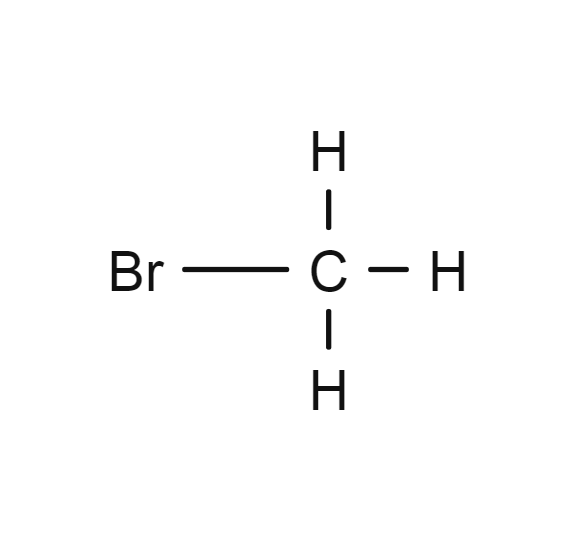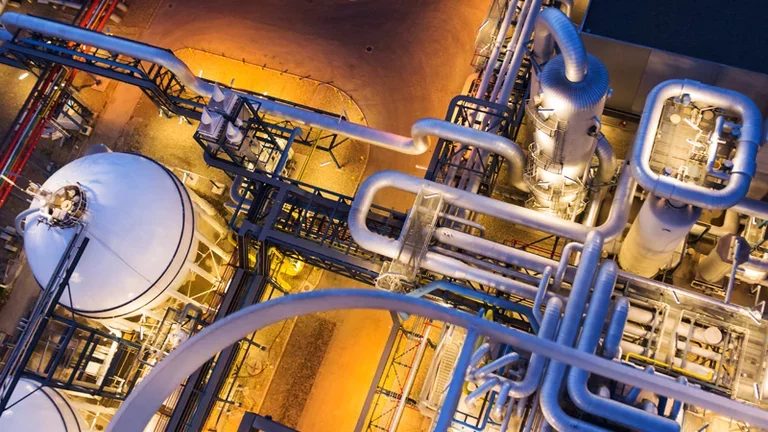
Methyl bromide
- CH3Br
- CAS Number 74-83-9
- UN1062 (gas)
Click & drag to move the 3D molecule
Liquid / Gas Volumes
Calculate the volume or mass of a quantity of gas or liquid
Liquid Phase
At boiling point at 1.013 bar
Gas Phase
In standard conditions (1.013 bar, 15°C)
Physical Properties
Molecule phase diagram showing the transition phases between solid, liquid and gas as a function of temperature and pressure
-
- Molar mass 94.939 g/mol
- Content in dry air /
-
Critical Point
- Temperature 190.85 °C
- Pressure 69.29 bar
- Density 624.60 kg/m³
-
Triple Point
- Temperature -93.71 °C
- Pressure 2.07E-3 bar
Pressure 1.013 bar
| Latent heat of fusion (at melting point) | 62.977 kJ/kg |
| Melting point | - 93.71 °C |
Pressure 1.013 bar
| Boiling point | 3.51 °C |
| Latent heat of vaporization (at boiling point) | 253.396 kJ/kg |
| Liquid density (at boiling point) | 1721.37 kg/m3 |
Applications
Examples of uses of this molecule in Industry and Healthcare

Chemicals
Methyl bromide is used as a methylating agent in various chemical reactions and as a solvent.

Other
Methyl bromide is used to control fungi, insects and rodents.
Safety & Compatibility
GHS04
Gas under pressure
GHS06
Acute Toxicity
GHS08
Serious health hazard
GHS09
Hazardous to the environment
Autoignition Temperature, Flammability Limits & Flash Point
Europe (according to EN1839 for Limits and EN 14522 for autoignition temperature)
| Autoignition temperature (Chemsafe) | 535 °C |
| Lower flammability limit (IEC 80079-20-1) | 8.6 vol% |
| Upper flammability limit (IEC 80079-20-1) | 20 vol% |
US (according to ASTM E681 for Limits and ASTM E659 for autoignition temperature)
| Autoignition temperature (NFPA 325) | 537 °C |
| Flash point (NPFA 325) | Practically nonflammable |
| Lower flammability limit (NFPA 325) | 10 vol% |
| Upper flammability limit (NFPA 325) | 16 vol% |
Threshold of toxicity
| PEL USA OSHA (vol) | 20 [ceiling] ppm |
Odor
Chloroform like
Metals
| Aluminium | Not recommended |
| Brass | Satisfactory |
| Monel | Satisfactory |
| Copper | No data |
| Ferritic Steel | Satisfactory |
| Stainless steel | Satisfactory |
| Zinc | No data |
| Titanium | No data |
Plastics
| Polytetrafluoroethylene | Satisfactory |
| Polychlorotrifluoroethylene | Satisfactory |
| Polyvinylidene fluoride | Satisfactory |
| Polyvinyl chloride |
Significant swelling
Not recommended
|
| Ethylene tetrafluoroethylene | No data |
| Polycarbonate |
Significant swelling
Not recommended
|
| Polyamide | Satisfactory |
| Polypropylene |
Significant swelling
Not recommended
|
Elastomers
| Butyl (isobutene- isoprene) rubber |
significant swelling
Not recommended
|
| Nitrile rubber |
significant swelling
Not recommended
|
| Chloroprene |
significant swelling
Not recommended
|
| Chlorofluorocarbons | No data |
| Silicone |
significant swelling
Not recommended
|
| Perfluoroelastomers | Satisfactory |
| Fluoroelastomers | Satisfactory |
| Neoprene | No data |
| Polyurethane |
Significant swelling
Not recommended
|
| Ethylene-Propylene |
Significant swelling
Not recommended
|
Lubricants
| Hydrocarbon based lubricant |
Significant loss of mass
Not recommended
|
| Fluorocarbon based lubricant |
Significant loss of mass
Not recommended
|
Materials compatibility
Learn More
More information
Due to their ozone-depleting effect, the production of refrigerants is continuously decreasing, based on Montreal protocol requirements. Their use is controlled and they are progressively being replaced.